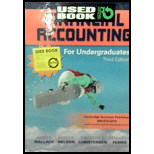
a)
Calculate the following ratios:
- 1) Return on sales ratio
- 2) Return on assets
- 3) Return on common
stockholders’ equity - 4) Quick ratio
- 5)
Current ratio - 6) Debt to equity ratio
a)
Explanation of Solution
1) Return on sales ratio: The ratio which evaluates the amount of net income earned for every dollar of net sales is referred to as return on sales ratio. Higher ratio indicates highly profitable company.
Compute the return on sales ratio for Company L for the year 2016.
Net income= $680,000
Net sales = $8,800,000
Hence, return on sales ratio for 2016 is 7.85%.
2) Return on assets: Return on assets is the financial ratio which determines the amount of net income earned by the business with the use of total assets owned by it. It indicates the magnitude of the company’s earnings with relative to its total assets.
Compute return on assets ratio for 2016:
Net income = $680,000
Average total assets = $4,905,000 (1)
Therefore, the company’s accounts return on assets ratio for 2016 is 13.76%.
Working note:
Compute average of total assets:
Beginning total assets - $4,870,000
Ending total assets - $5,500,000
3) Return on common stockholders’ equity ratio:
Compute the return on common stockholders’ equity for the Company L for the year 2016.
Net income = $680,000
Average common stockholders’ equity = $2,435,000 (2)
Preference dividends = $65,000
Hence, return on common stockholders’ equity for 2016 is 25.25%.
Working notes:
Compute average stockholders’ equity for 2016:
Beginning balance of common stockholder’s equity = $2,170,000
Ending balance of common stockholder’s equity = $2,700,000
Note: common stockholders’ equity includes the common stock and retained earnings.
4) Quick Ratio: It is a ratio used to determine a company’s ability to pay back its current liabilities by liquid assets that are current assets except inventory and prepaid expenses.
Compute Quick ratio for 2016:
Therefore, quick ratio for 2016 is 0.64 times.
5) Current ratio: Current ratio is one of the liquidity ratios, which measures the capacity of the company to meet its short-term obligations using its current assets. The ideal current ratio is 2:1. The following formula is used to calculate current ratio.
| Quick assets | $385,000 |
| Inventory and prepaid expenses | $950,000 |
| Total current assets | $1,335,000 |
| Current liabilities | $600,000 |
Table (1)
Compute current ratio for 2016.
Therefore, current ratio for 2016 is 2.225 times.
Note: “Other assets” are considered as non-current assets. Hence, it is not included in the total current assets.
6) Debt-equity ratio: The debt-to-equity ratio indicates that the company’s debt as a proportion of its stockholders’ equity.
Compute debt to equity ratio for Company L for the year 2016.
Total stockholders’ equity = $1,900,000 (3)
Total liabilities = $3,600,000 (4)
Therefore, debt to equity ratio for 2016 is 0.52:1.
Working notes:
Compute the total liabilities:
Compute the total stockholders’ equity:
b)
Compare Company L’s performance with industry performance
b)
Explanation of Solution
Compare the Company L Performance with the industry performance.
- The return on sales ratio (7.85%) of the company is better than the average industry performance.
- The return on assets ratio (13.76%) of the company is better than the average industry performance.
- The return on common stockholders’ equity (25.25%) is better than the average industry performance.
- The quick ratio (0.64:1) is below the average industry performance.
- The current ratio (2.22:1) is similar to the average industry performance.
- The debt-to-equity ratio (0.52:1) is better than the average industry performance.
Want to see more full solutions like this?
Chapter 13 Solutions
FINANCIAL ACCT.F/UNDERGRADS-W/ACCESS

 AccountingAccountingISBN:9781337272094Author:WARREN, Carl S., Reeve, James M., Duchac, Jonathan E.Publisher:Cengage Learning,
AccountingAccountingISBN:9781337272094Author:WARREN, Carl S., Reeve, James M., Duchac, Jonathan E.Publisher:Cengage Learning, Accounting Information SystemsAccountingISBN:9781337619202Author:Hall, James A.Publisher:Cengage Learning,
Accounting Information SystemsAccountingISBN:9781337619202Author:Hall, James A.Publisher:Cengage Learning, Horngren's Cost Accounting: A Managerial Emphasis...AccountingISBN:9780134475585Author:Srikant M. Datar, Madhav V. RajanPublisher:PEARSON
Horngren's Cost Accounting: A Managerial Emphasis...AccountingISBN:9780134475585Author:Srikant M. Datar, Madhav V. RajanPublisher:PEARSON Intermediate AccountingAccountingISBN:9781259722660Author:J. David Spiceland, Mark W. Nelson, Wayne M ThomasPublisher:McGraw-Hill Education
Intermediate AccountingAccountingISBN:9781259722660Author:J. David Spiceland, Mark W. Nelson, Wayne M ThomasPublisher:McGraw-Hill Education Financial and Managerial AccountingAccountingISBN:9781259726705Author:John J Wild, Ken W. Shaw, Barbara Chiappetta Fundamental Accounting PrinciplesPublisher:McGraw-Hill Education
Financial and Managerial AccountingAccountingISBN:9781259726705Author:John J Wild, Ken W. Shaw, Barbara Chiappetta Fundamental Accounting PrinciplesPublisher:McGraw-Hill Education





